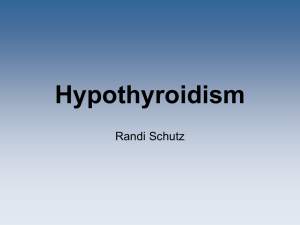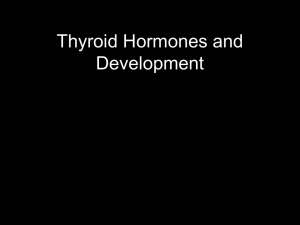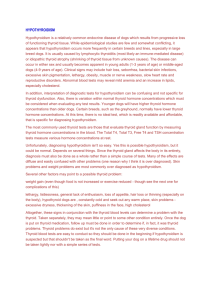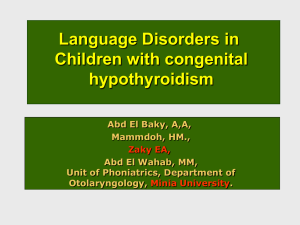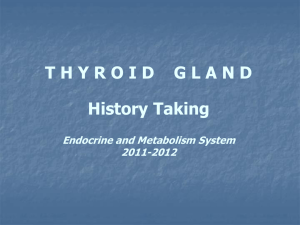cross sectional study of cardiovascular manifestations of
advertisement
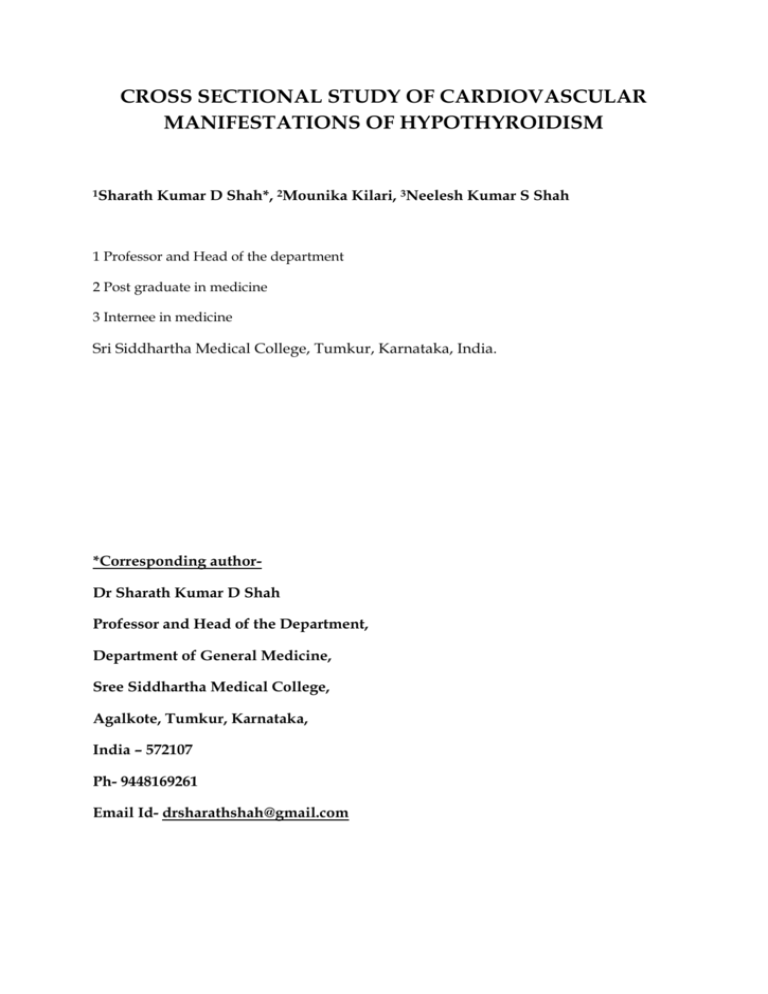
CROSS SECTIONAL STUDY OF CARDIOVASCULAR MANIFESTATIONS OF HYPOTHYROIDISM 1Sharath Kumar D Shah*, 2Mounika Kilari, 3Neelesh Kumar S Shah 1 Professor and Head of the department 2 Post graduate in medicine 3 Internee in medicine Sri Siddhartha Medical College, Tumkur, Karnataka, India. *Corresponding authorDr Sharath Kumar D Shah Professor and Head of the Department, Department of General Medicine, Sree Siddhartha Medical College, Agalkote, Tumkur, Karnataka, India – 572107 Ph- 9448169261 Email Id- drsharathshah@gmail.com AbstractHypothyroidism is a silent disease prevailing in the population. Careful observation and identification of patients is necessary as it is manifested lately. There are very few researches pertaining to cardiac manifestations of hypothyroidism. This study was conducted in order to identify the cardiac manifestations of hypothyroidism at a very early stage like detection itself. The study was conducted in 30 newly identified hypothyroid patients. A detailed clinical history was taken along with routine investigations and special investigations like thyroid profile, fasting lipid profile, ECG and ECHO. In the study group female preponderance was present accounting for 73.33%. Most common symptoms are weight gain, lethargy, dry skin, hoarseness of voice. Cold intolerance was found in 50% and menstrual symptoms found in 59%. On general examination weight gain was found in 76.66%, dry skin in 63.33%, bradycardia in 30% and hypertension in 23%. On systemic examination delayed ankle jerk was found in 66.66%. Based on ECG findings abnormal were 70%and low voltage complexes were 35%. On echocardiography normal findings were found only in 30%, pericardial effusion was found in 26.7% and diastolic dysfunction was found in 26.67%. Our study proved that in newly detected hypothyroid patients, it is always advisable to perform fasting lipid profiles and echocardiography in order to identify the cardiac manifestations which are very commonly found in them. KeywordsCardiovascular manifestations, Diastolic dysfunction, T3 T4 TSH, ECG, ECHO, Hypothyroidism, Lipid profile, Pericardial effusion IntroductionHypothyroidism is a clinical syndrome resulting from a deficiency of thyroid hormones, which in turn results in a generalized slowing down of metabolic processes. Hypothyroidism is fairly common in that it affects 2% of adult women and 0.1-0.2% of adult men. Thyroid hormones exert direct cellular effects on almost all tissues of the body. It causes multi organ dysfunction due to deranged metabolism.1 Cardiovascular complications are some of the most profound and reproducible clinical findings associated with thyroid disease. Hypothyroidism is associated with increased cardiovascular mortality and morbidity. The dysfunction ranges from functional systolic/diastolic dysfunction to overt failure and coronary artery disease.2 The need for the study is that, there are only few studies done in our country to assess the cardiovascular parameters in hypothyroid patients. Cardiovascular abnormalities associated with hypothyroidism attracted a great deal of investigation effort. Thus the need of this study is to assess the CVS parameters in new hypothyroid patients by ECG and ECHO. The completely reversible nature of these complications is well known. Hence this study aims at studying the cardiac manifestations of hypothyroidism, thereby reassessing the need for early recognition and more aggressive management of the disease and thus aiming at preventing the aforementioned complications. Aims & ObjectivesTo study cardiac manifestations in newly diagnosed hypothyroid patients. Material & MethodsSource of data30 newly detected cases of Hypothyroid coming to Sree Siddhartha Medical College and Hospital are considered to be the subjects. Study duration- March 2013- May 2013 Inclusion criteria- Hypothyroid patients which include a) Newly diagnosed patients b) Detected hypothyroid patients not on treatment c) Patients on L- thyroxin for less than four months. Exclusion criteriaa) Patients with known cardiac disease b) Patients with Chronic obstructive pulmonary disorder, severe anaemia, diabetes mellitus or any other endocrinal disorder. c) Patients taking medications that alter the thyroid function like beta blockers, lithium, oral contraceptive pills, steroids and alcohol. Investigations1. T3, T4, TSH 2. Haemoglobin, Total count, sedimentation rate. 3. Random blood sugar 4. Urine routine and microscopy 5. Blood urea 6. Serum creatinine 7. Lipid profile 8. A standard 12 lead ECG 9. Echocardiography Differential count, Erythrocyte T3, T4, TSH levels3ml of early morning fasting samples containing plain clotted blood are collected and sent for estimation. The hormonal essay was done by chemiluminescence assay. EchocardiographyDiastolic dysfunction was assessed by means of the Canadian consensus criteria. Patients were grouped under the following 5 groups if at least four of the criteria have been met. Canadian consensus for diastolic dysfunction- 3 GRADE NORMAL MILD MILD-MOD MODERATE SEVERE TRANSMITRAL FLOW RATES E/A Dt S/D 1-2 150-200 ≥1 <1 >200 ≥1 <1 >200 ≥1 1-2 150-200 0.5-1 >2 <150 <0.5 P.V.F AR <0.35 <0.35 ≥0.35 ≥0.35 ≥0.35 AR-A <20 <20 ≥20 >20 >20 Systolic DysfunctionIt is evaluated using the systolic time intervals as in other studies by workers like Edward W Bough.4 PEP or Pre Ejection Period is the time period between the R wave on ECG and opening of the aortic valve. It is the time interval between the electrical and mechanical activation of heart. PEP is <105 msec in males and <110 msec in females. LVET is the time between the opening and closure of aortic valve. LVET values range from 320-340 in males and 330-350 in females. PEP/LVET ratio is a heart rate and sex independent that is 0.34±0.42 A value >0.76 is taken as the diagnostic of systolic dysfunction. Patients were categorized into two groups, either with or without systolic dysfunction.4 Statistical Methods1. 2. 3. 4. Measures of central tendency Measures of dispersion Standard error of difference between two means Graphical representation of the data Study designA cross sectional clinical study consisting of 30 new cases of hypothyroidism is undertaken to study the cardiac manifestations by ECG and ECHO. Ethical clearance- The clearance for the study was obtained from the ethical committee of Sree Siddhartha Medical College and Hospital, Tumkur, Karnataka, India. Consent form- An informed consent was taken from all the participants. ResultsMost cases fell in the age group of 31-40 years. The mean age was 35 years. There was an overall female preponderance with mean age 34.6 years. The female population constituted about 73.33% of the total. Most common symptoms are weight gain, lethargy, dry skin, hoarseness of voice. Cold intolerance was found in 50% of patients and menstrual symptoms in 59% of females. None of the patients had history suggestive of proximal muscle weakness. On general examination most common findings are weight gain and dry skin found in around 76.66% and 63.33% respectively. Goitre was found in 3% of patients, bradycardia was found in 30% and hypertension above 140/90 mmHg was found in 23% of patients. On systemic examination diminished heart sound was found in 26.66% patients. CNS examination revealed delayed ankle jerk of 66.66% followed by hoarse voice. Lipid analysis showed increase of Total cholesterol, Low density Lipoprotein, Very Low Density Lipoprotein, Triglycerides and decrease of High Density Lipoproteins in mild, moderate and severe cases. Standard error of significance between means among mild and moderate is not significant except triglycerides where actual difference was more than twice the standard error of difference thus significant. Normal ECG was found in 30% of patients. Bradycardia was most common finding seen in 40% patients. Low voltage complexes were seen in 33% patients. ECHO findings are normal in 30% cases. Pericardial effusion was next common finding seen in 26.7% cases. Diastolic dysfunction was seen in 26.67%, majority of them being mild dysfunction. No cases were found to have severe diastolic dysfunction. Inter ventricular septum thickening found only in 2 cases. The remaining routine investigations conducted have no significant findings in relation to hypothyroidism. 14 13 12 10 10 10 8 8 MALE FEMALE 6 TOTAL 4 4 3 3 2 2 2 2 2 1 0 21-30 31-40 41-50 51-60 Table 1: Age and Sex distribution of the study group SYMPTOMATOLOGY 25 22 20 19 20 16 15 15 15 13 9 10 8 NUMBER OF PATIENTS 5 0 Table 2: Distribution of symptomatology findings GENERAL EXAMINATION FINDINGS 23 25 19 20 15 10 5 0 12 8 6 13 7 3 NUMBER OF PATIENTS Table 3: Distribution of general examination findings SYSTEMIC EXAMINATION 25 20 20 16 15 8 10 5 NUMBER OF PATIENTS 2 0 Cardiomegaly Diminished heart sounds Delayed ankle jerk Hoarse voice Table 4: Distribution of various systemic examination findings SEVERITY OF HYPOTHYROIDISM 14 13 12 10 10 8 7 6 NUMBER OF PATIENTS 4 2 0 Mild 0.5-20 Mu/L Moderate 20-50 Mu/L Severe >50 Mu/L Table 5: Severity of Hypothyroidism according to Thyroid Stimulating Hormone levels. ECG findings 14 12 12 10 9 10 8 8 6 4 3 2 2 NUMBER OF PATIENTS 0 Table 6: Frequency of various ECG findings 12 10 10 8 8 7 6 4 2 2 2 1 0 0 NUMBER OF PATIENTS Table 7: Number of patients showing various 2D Echo findings PERICARDIAL EFFUSION 25 21 20 15 NUMBER OF PATIENTS 10 4 5 4 1 0 Absent Mild Moderate Large Table 8: Prevalence of Pericardial effusion in the study group DiscussionThe age range of the study is between 21-60 years. Most patients belong to the age groups of 31-40 years. There was an overall female preponderance. Similar demographic profile was mentioned in most of medicine text books including Harrison Textbook of Internal Medicine.1 The most common of the symptoms included weight gain, lethargy, dry skin, hoarseness of voice and constipation. The diagnosis of hypothyroidism may be overlooked for several years because of the insidious and non-specific nature of symptoms that further complicates the detection of hypothyroidism.5 In our study on general examination most common findings are weight gain, dry skin and goitre. Delayed relaxation of ankle jerk is the most common finding present which correlates well with the description in most standard textbooks of endocrinology. On cardiovascular examination bradycardia was the main finding found followed by cardiomegaly which seeks importance. Dyslipidemia is a common metabolic abnormality in patients with thyroid disease, either in the overt or subclinical forms of the disease, and constitutes the end result of the effect of thyroid hormones in all aspects of lipid metabolism leading to various quantitative and/or qualitative changes of triglycerides, phospholipids, cholesterol, and other lipoproteins.6 In our study there is increase of Total cholesterol, LDL, VLDL, triglycerides and decrease of HDL. This is also in agreement with the literature given in Williams Textbook of endocrinology. Majority of the study group showed abnormal ECG which constitutes bradycardia followed by low voltage complexes. On ECHO the finding of pericardial effusion is found in a significant group of people which correlates with the study conducted by Kabadi et al.7 ConclusionIt is very important to have a high degree of suspicion in assessing the patients having a vague presentation of symptoms. In this study consisting of newly detected hypothyroid patients, bradycardia was the most common abnormal finding followed by low voltage complexes. Pericardial effusion was the most common abnormal finding in ECHO. Any unexplained pericardial effusion should be screened for Hypothyroidism. It is always advisable to screen hypothyroid patients for cardiac abnormalities as its being more common among them so that early identification and cure can provide healthier life ahead. References1. Jameson JL, Weetman AP. Disorders of the thyroid gland. In: Longo DL et al, Harrison’s Principles of Internal Medicine, 18th ed: Mc Graw Hill; 2012:2918-22 2. Rawat B, Satyal A. An echocardiographic study of cardiac changes in hypothyroidism and response to treatment. Kathmandu University Medical Journal. 2003. Vol 2. 3(7):182-87 3. Yamada et al. Prevalence of Left Ventricular Diastolic Dysfunction by Doppler Echocardiography: Clinical applications of the Canadian Consensus Guidelines. J Am Soc Echocardiography. 2002; 15:1238-44 4. Bough EW, Crowly WF. Myocardial function in Hypothyroidism. Archives Internal Medicine. Vol 2. 1978 Oct 5. Paudel B, Paudel K, Upadhaya TL. Clinical manifestation of hypothyroidism in residents of western region of Nepal: A case control study. Nepal Journal of Medical Sciences. 2013; 2(1):62-5 6. X. Zhu and S. Y. Cheng, “New insights into regulation of lipid metabolism by thyroid hormone,” Current Opinion in Endocrinology, Diabetes and Obesity, vol. 17, no. 5, pp. 408–413, 2010. 7. Kabadi UM, Kumar SP. Pericardial effusionin primary hypothyroidism. American Heart Journal. 1990 Dec; 120(6):1395-5

